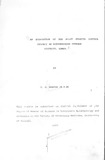| dc.description.abstract | Hydatidosis (Hydatid disease) 1S a cyclozoonotic
disease caused by the larval stages of Echinococcus
granulosus. The disease is mainly transmitted between
carnivores and herbivores. The most important cycle is the
one which involves dogs and domestic livestock.
A pilot hydatid control project was started in 1983 in
the Northwestern part of Turkana District 1n Kenya
(Macpherson et al., 1986). This area is known to have one
of the highest prevalences and incidences of hydatidosis
and echinococcosis in the world (French and Nelson, 1982).
Since the pilot hydatid control project was initiated, no
efforts had been made to assess the impact of the control
measures effected against these diseases.
This study was therefore initiated to assess whether
the dog control measures undertaken in the Control area
(Macpherson, 1986) had any impact Dn the prevalences of dog
echinococcosis and human hydatidosis. In addition, this
study tried to investigate whether the education measures
undertaken alongside the dog control measures had been
understood.
The study region was divided into three areas namelYi
the Control area where control measures were undertaken, an
Intermediate area where little control measures were
implemented and a Non control area where no measures
against the disease were applied.
In an effort to assess the effects of the control
programme on the prevalence of echinococcosis in dogs, 808
dogs were killed and examined for the presence of
Echinococcus granulosus worms. The results showed that
Control area had a prevalence of 38.5%, the Intermediate
area 41% and the Non-control area a 50.6%. Each of these
was significantly different from the 63.5% recorded in
Control area at the beginning of the programme.
The presence or absence of Taenia hydatigena in dogs
as an indicator of dogs being fed on raw offal was also
examined. The highest prevalence (90.4%) was recorded in
the Non-control area followed by 84.3% in the intermediate
area and 64.7% in the Control area. This indicated that the
Turkana people still fed dogs offal infected with hydatid
cysts.
During this study, 12,122 people were examined to
determine the prevalence of human hydatidosis. A prevalence
of 3.8% was obtained ln the whole study region. A
prevalence of 3.7% was recorded in the Control area, 4.4~
in the Intermediate area and 4.2% in the Non control area.
The significant risk factors for this disease and obtained
were, sex, previous operation and settlement status.
In the assessment of the knowledge on hydatid disease
among the Turkana, 3,416 people were interviewed. One
thousand five hundred and eighty four (1,584) people were
from the Control area, 700 from the Intermediate area and
1,132 from the Non control area. The interviewees were
classified into three categories namely; those with
"complete"
knowledge" .
knowledge, "partial" knowledge and "no"
Two thousand one hundred and fourty four (62.7%) of
the people fell in the "partial" Knowledge group followed
by 1151 (33.7%) who had "no" knowledge and 1121 (3.5%) who
had "complete" knowledge. Out of 393 people who had
obtained knowledge on hydatid di se'ase from African Medical
and Research Foundation (AMREF), 316 (80.4%) were found in
the Control area, 37 (9.4%) were found in the Intermediate
area and 40 (10.2%) were from the Non control area. A
similar trend was found in the school children, although a
higher number 30 (9%) of school children had "complete"
knowledge about the disease than adults who either had
"partial" or "No" knowledge.
In conclusion, the present study indicated that the
prevalence of human hydatidosis had not significantly
changed since the inception of the pilot Hydatid Control
Project. The failure to achieve a significant decline in
the prevalence of human hydatidosis could be due to the
fact that the disease takes long to manifest itself, the
recurrence of the disease and failure of the Turkana to
seek medical attention in time. But the prevalence of dog
echinococcosis had declined significantly. This decline
could possibly be associated with the control measures
undertaken against this disease. The high prevalences of T.
hydatigena showed that dogs were still gaining access to
offal infected with cysts.
Considering that there had been no other control
measures instituted before 1983, results from this study
indicates that the control programme has had some positive
effects on the knowledge of hydatid disease though not
significant enough to alter the magnitude of this disease
within a short time.
There were various organisations involved in the
dissemination of knowledge on hydatid disease not only in
the Control area, but also in the other two study areas,
but AMREF was more important in the dissemination of the
knowledge. The other organisations were Turkana
Rehabilitation Project (TRP) and the Catholic mission. | en |

